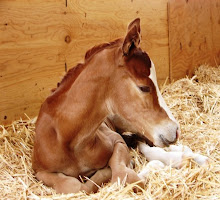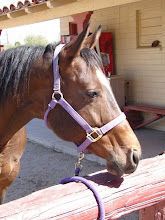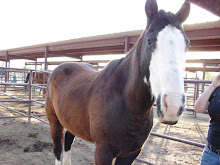"I love Rose and there isn't anything we can do about what's happening so we are just rolling with the punches as they come along. I think we are meant to have both Rose and her foal in our lives so we just have to wait and see what happens."
Usually the reaction is one of pride and admiration, especially from other horse people who tell us that we're behaving so maturely and that such a surprise couldn't be handled by better people, blah blah blah. It's all very nice and good, but these people don't have to be responsible for this colt's upbringing, Rose's re-training, or paying the bills.
Three weeks into Remi's life, we still weren't sure what to expect but I kept telling myself that the foal was finally born and there would be fewer uncertainties now. Riiiight.
Barn manager Nancy approached us just before Remi was born and suggested putting mare and foal into one of the barn stalls, as they would have more room there. The barn stalls all consist of an indoor portion with three full walls and one half wall, that half wall acting as a doorway to the "run" portion of the stall. Pipe fencing extends the size of the stall, but no shade over top of the enclosure. Most box stalls are 12 feet square and the attached run is 12' by 16'. The particular stall Nancy was referring to actually was two stalls whose runs had been connected by taking out the center divider between the outdoor runs. One box stall was closed off and the other box stall acted as a feeding area and a shelter, then the run was twice the size of a normal run. This was a much better alternative to the 12' x 14' foaling stall Rose was in currently. Nancy said that she could let us keep the horses in that stall for the same monthly fee we were paying already, since she knew money was an issue for us. The caveat was that we would have to fix up the stall they would go into. I eagerly accepted her gracious offer, but told her we would not be moving Rose until after the foal was at least three weeks old. She tried to pressure us into moving Rose immediately but we refused. The new stall needed a lot of work done and I did not want to stress Rose out by moving her yet again, especially with the birth so imminent. The benefit of the smaller foaling stall was that it was already boarded up properly and was entirely in the shade. It is so important to help regulate a newborn foal's temperature in its first few weeks of life, as they cannot do so themselves. Remi was born in the middle of July and spent his first couple of months in extremely high temperatures. Their foaling stall was equipped with a mist system and three box fans to circulate the air, not to mention giant tubs of fresh water and daily baths to help cool both horses.
We tentatively began plans to fix up the stall in the barn, Teri performing measurements and pricing out new plywood. We could only use a select few pieces of plywood from the foaling stall because the new stall needed much taller sections. The bottom rail was removed on all sides of the new stall, so the plywood had to be the regular four feet tall, and the foaling stall plywood was only two feet tall. Another thing to consider was that the horses would be in this stall for the next five to six months so we needed to try and make the wood last as long as possible. This meant protecting it from the elements and securing it properly to the fencing.
Before we knew it, the time to move the horses was upon us. We chose a weekend and decided that we needed to get all the work done on the new stall so we could move the horses by that specific weekend. First we headed to Lowe's to buy all new plywood sheets. We also needed exterior waterproof paint to keep the plywood dry, as well as extra long zip ties, a couple of new drill bits and a reciprocating saw blade. Our good friends Katie and Berto agreed to help with this endeavor, thankfully, because we could not have done it without them. It was the middle of August and the weather was miserably hot and sticky, since we were in monsoon season and the humidity was high. Early in the morning before even going to the barn, Teri and I painted the front and back of about three quarters of the plywood sheets before realizing that the paint we'd bought was really thick and wasn't covering as well as we hoped. We painted all the remaining sheets white on one side, then on the reverse sides of those we painted a dark brown color. It was an exterior paint we had leftover from last Christmas. When those were dry, we loaded them in the bed of the truck and headed to the barn.
Once we arrived, we developed a system of stations that each board needed to pass through, like an assembly line. First, Katie's station was at the bed of the pickup. She brought a router from Centennial Hall to round the edges of all the plywood. She and Teri routered edges, then brought the sheets back to me for touchups in the paint. Then the sheets went to Berto for drilling holes for the zip ties, then he carried them to the stall. I removed a few sheets of plywood from the foaling stall and painted them while everyone was working. I finished the majority of the painting before the rest of the stations were completed, so I went to work on the box stall.
I crouched down and duck-walked all over the outside run and inside the stall, looking for nails or metal pieces or glass or anything harmful. I even chucked large rocks out of the run. I took a shovel and a garden aerator tool into the box stall to even the surface out. It had a large hump in the middle and then a big dip, so the hardpacked dirt had to be loosened and leveled. I wiped out the feeder, cleaned out the waterer, and shoveled old dirt and manure out of the stall. The blocked off second box stall became a highly convenient storage area, where we put the extra plywood, grain bin, extra straw bales, grooming supplies, and a bunch of other crap we didn't want to deal with.
I spread a whole bale of straw in the newly leveled and cleaned box stall and made sure there was fresh water.
By this time, Berto had already touched up the routed edges of the plywood sheets I missed and drilled them. He and Katie began digging a small trench around the stall where the plywood sheets would be sunk into the ground, only a few inches deep. Teri's parents called then, in the middle of the day. I heard Teri answer the phone from inside the barn.
"Yeah, we're at the barn today working on the new stall.
She came into the run and asked, "What do you guys want from Eegees? My parents are bringing lunch."
We all looked up and simultaneously chanted, "EEGEES!"
Teri laughed and spoke into the phone again. "Yeah, they all want Eegees.
She looked questioningly at Katie and Berto.
Berto said, "I'll have a lemon one, thanks."
"I'll just have strawberry too." Katie added.
"Yeah, so three strawberries and a lemon. No, nobody wants any food, it's too freaking hot. Okay thanks, see you in a bit." She slid her phone shut and wiped her face on her sleeve.
"They're leaving the house now." Teri leaned on the end of the shovel handle, one booted foot perched on the top of the blade.
Everyone was exhausted and drenched in sweat. My hair was plastered to my neck and forehead, since I regularly visited the water fountain to soak my head in the cold water. We all had drained our water bottles and refilled them numerous times. Katie and Berto resumed their trench, while Teri and I started lining up plywood sheets with where they would be attached to the fencing. We had a small issue with the gate from the run, since the plywood there would have to be the exact width of the gate or the gate wouldn't open. For that, Teri trimmed a piece of plywood with the reciprocating saw while I sat on the piece to keep it from jumping around.
We began attaching the plywood in the areas that the trench was completed. Set the sheet into the trench, then thread the black zip ties through the carefully measured and drilled holes. The person on the inside would push the tip of the tie back through so the outside person could zip them shut. After all the ties were loosely attached, we would make all the ties as tight as possible, always making sure the long ends were outside the stall.
We had only done one or two pieces when Gene and LeEllen drove up in their Nissan Pathfinder. They got out with all the cold, icy Eegee treats they'd brought for us and we all gladly abandoned our work under the full sun. The group of us sat in the shade, spooning sweet and cold Eegees into our mouths and chatting. It was a much needed break from the work and from the sun. Our hands were blistered and raw from the wood and the tools, necks arms and faces sunburned.
When we could no longer pretend there was still some cold Eegee tastiness to consume, we thanked Gene and LeEllen and continued work on our project. Thankfully, there wasn't too much work left. Katie and Berto finished their trench and started attaching sheets of plywood alongside Teri and I. We had all the sheets up and attached firmly by late afternoon, but there was still a gap where a few pieces had to be put up. Those pieces were still being used in the foaling stall, so I told Teri I would come back the following day and finish up. We called it a day. Katie took the router back to Centennial and Berto went home. Teri and I fed and patted the horses, cleaned up a little of our mess, then went home as well.
The next morning, I got a phone call.
"Ashleigh? This is Nancy from Foothills. I just wanted to call and tell you that your little baby got stuck halfway in and halfway out of his stall this morning! He's okay but you really should move them out of there before he gets into some real trouble."
"Oh my god, how did he get stuck?"
"Well honey I don't know because I wasn't there, but the trainer called me to tell me the baby was stuck so I called the guys and they came out and pushed him out from under the rail, then Alison just put his little halter on and put him back in the stall."
"Oh well I'm glad he's okay. I'm coming out today to finish the stall in the barn and I'm going to move them over there."
"Alright well I just wanted you to know he got stuck. I'll see you later!" Nancy hung up the phone.
That was just what I had worried about happening! That's why we line stalls with plywood, to prevent the babies from laying down and scooting on their sides and getting out of the stall. In Remi's case, he didn't wiggle far enough to escape completely and got stuck halfway in and out. The concern is that the baby will panic and try too hard to get up, breaking his back or neck in the process. Luckily, he kept his head and just let the trainer and the caretakers fix the problem. Thank goodness we had just gotten past the whole lead rope issue!
I went back to the barn and finished attaching the last few sheets. Teri joined me after work and we turned them out in the main arena, since Remi had proven to us that we couldn't put him in the jumping arena anymore. They ran around for awhile, rolled and bucked and kicked and had a grand ol' time. When we took them out of the arena, we led them into the barn stall instead of the foaling stall. Rose was definitely upset that she had a neighbor horse who was very interested in Remi, but Remi was excited to be in a new place and didn't seem to notice his nosy neighbor.
Over the next couple days, I stripped all the leftover plywood off the foaling stall, cleaned up all the old zip ties, and raked the leftover straw bedding into the center of the stall. That way the cleanup would be easy for the caretakers. We rolled up the tarp we used to paint on and took the paint cans home.
About a week after our great plywood adventure, I got another call from Nancy. I didn't feel up to talking to her, so I let the call go to voicemail. I dialed my voicemail and listened to her message.
"Hi Ashleigh, this is Nancy from Foothills. I just wanted to ask you to clean up your old stall so I can rent it out, there's still bedding and trash and stuff everywhere so please clean it up as soon as you can. Thanks, bye."
Yeah right! I DID clean up the stall, woman! I raked the bedding into a nice pile, I picked up all the trash by hand and I even washed out the water barrel. All that needed to be done is the bedding picked up and put into the manure dumpsters, which I couldn't do anyway. The dumpsters were so tall that only the tractor could put manure and old bedding in there so there was no point in me picking it all up - I'd have nowhere to put it.
I ignored the voicemail. The next time I went out there, I walked over to the foaling stall and looked around. No trash, no anything but the pile of straw in the center of the stall.
The more I thought about it, the madder I got. Isn't it part of the caretaker's job descriptions to muck stalls? Why should I be responsible for making a stall ready to rent out again? Didn't we spend over eight hours working on the stall we moved Rose and Remi into? Is it right that we had to put in so much work on the new stall and then be expected to fully prepare the old stall to be used by another horse? Absolutely not. I decided I would not do any more work on the old stall than had already been done. Now I was not just annoyed, I was outraged.
Days went by and Rose and Remi adjusted to life in a barn, in a large stall. Before too long, Rose wasn't pinning her ears and snapping her teeth when the mare next door tried to get a peek at Remi. Rose wasn't thrilled that she had a neighbor, but she quickly realized that Suzie couldn't get anywhere near her baby so she wasn't a threat. Suzie was the bay Thoroughbred mare right next door, and on the other side of Suzie was Star, a sorrel Arabian mare. Their owner's name was Susan (weird to own a horse named Suzie when your name is Susan, no?) and she told me that both mares had foals at some point in their lives, and they loved babies. Anytime we took Rose and Remi out, both Suzie and Star whinnied at them as we passed their stalls.
Nancy cornered me once while I was feeding to ask me about the foaling stall.
"So that stall still needs to be cleaned out before I can rent it to someone new." she admonished.
"Actually I have done all the work I am going to do on the old stall, since all that needs to be done now is the old straw removed and new bedding put down. I had to do a lot of work to get this stall ready and it isn't fair to expect me to clean out the old one. Nobody else cleans up their stalls if they move to a different one." I calmly replied.
She looked taken aback. She managed to sputter out something about,
"Oh okay well I'll just have the guys do it then..." and trailed the end of her sentence off. She spun on her heel and walked out of the barn.
Ironically, the next week I witnessed her personally mucking the old straw out of the stall and putting it into a wheelbarrow. Interesting. Maybe she told the guys not to do it in an attempt to get me to do it myself? Ha well that didn't work out so well for you, did it?
I was thankful that Rose and Remi's move was somewhat quiet, even if we did each lose about five pounds of waterweight the day we prepped the stall in the barn. They had more room and I felt confident of their safety. I felt like a burden had been lifted, albeit a small one.





Wow, that's an incredible amount of work. I'm amazed... I'm glad you've got such generous, hard working friends ;)
ReplyDelete